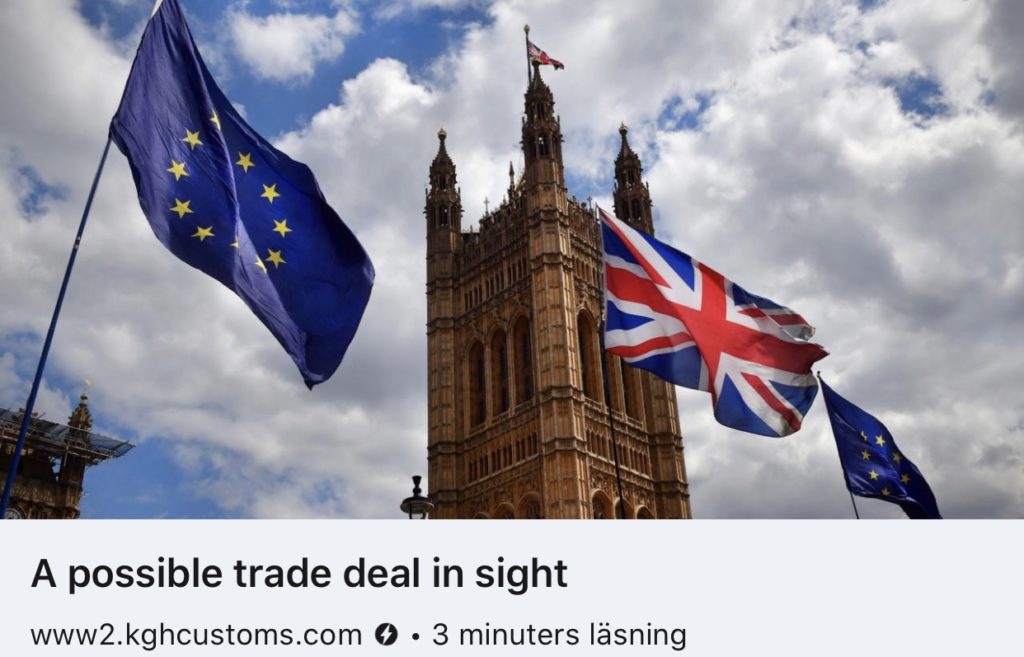A possible trade deal in sight
Don’t miss my latest blogpost on our KGH Brexit Blog, the Future Relations negotiations and the need for more preparations before the end of the transition period.

We are now less than three months away from the end of the Brexit transition period. KGH’s Lars Karlsson comments on the latest developments and on how trading companies should prepare.
Round 9 of negotiations between the UK and the EU on Future Relations took place in Brussels last
week. Perhaps a possible deal could be in sight?
After a period of stand-still, there are now signs and (in confidence confirmed) rumours of a breakthrough on trade could happen. There are still differences in fisheries and level playing field, while the trade agreement discussions are close to finalization.
There might be a landing zone possible before the critical EU Council meeting on 15-16 October, when a deal must be agreed to have time to secure ratification in 27+1 parliaments before the end of the year.
The deal discussed – and this is still confidential information from inside the negotiation teams – is a Free Trade Agreement (FTA), larger than a ”thin agreement” as mentioned before. So more product chapters included.
There is still a way to go and a lot of political craftsmanship is needed to make the deal. My estimation is that we have moved from 40/60 to 60/40 percent chance of a deal on trade being made.
Having said that, remember that a potential UK-EU FTA has no impact on the border procedures and formalities between the EU and UK. The UK Border Operating Model and the EU UCC demands declarations, supplementary documentation and a range of other obligations on traders (as on all EU third country imports and exports) will be implemented regardless of a deal or not.

A potential FTA will remove some of the customs duties that otherwise will be due in the trade between EU-UK. It is also important to note that while a potential FTA (the deal) is agreed it does remove tariffs for some products, but it also adds customs complexity concerning Rules of Origin, Valuation, restrictions and several other areas. Another area that will be impacted, from a border process perspective, is the NIP (trade GB-NI).
On the UK Border Operating Model (BOM) there are also some signs related to infrastructure that are worrying. As you know, exports from the UK and import to the EU will have to be pre-lodged before the transport reaches the border. There will be inland border posts where a truck will have to show that the customs declarations have been lodged correctly before the transports are allowed to approach the border, like e.g. the EuroTunnel or Dover Port for Ro-Ro. Same for other ports.
The infrastructure to handle this process is delayed. The Goods Vehicle Movement System (GVMS) that is under development to send a release note to transports will only be in tests in December. Also, the time frame to produce the physical infrastructure for the inland control posts, parking places etc have been questioned. The transit system is not well implemented yet, so there are few authorised consignors/consignees and guarantee facilities. For the Northern Ireland Protocol (WA NIP) there are an awarded Trader Support Service (TSS) under construction that will help traders sending goods GB-NI, however again the work has started late and there are some doubts on what can be ready for January 1st. There is a similar approach on the EU side, but the border facilities are to a larger extent in place.
Overall, preparations are now possible and must be done by all traders. It is also recommended to develop different plans for different scenarios. All companies Brexit preparations should be put to a test to map any gaps concerning the procedures and processes now announced. There will be border queues initially. It is also important to decide if to use the simplified procedure initially and if so how to handle compliance issues related to the delayed declaration of goods. Many companies have decided to implement the final border procedure, that will be obligatory from July 1st, already from January 1st to avoid risks and changes to internal processes and systems two times instead of one.
You find the article here: A possible trade deal is in sight
Source: KGH Brexit Blog
You must be logged in to post a comment.